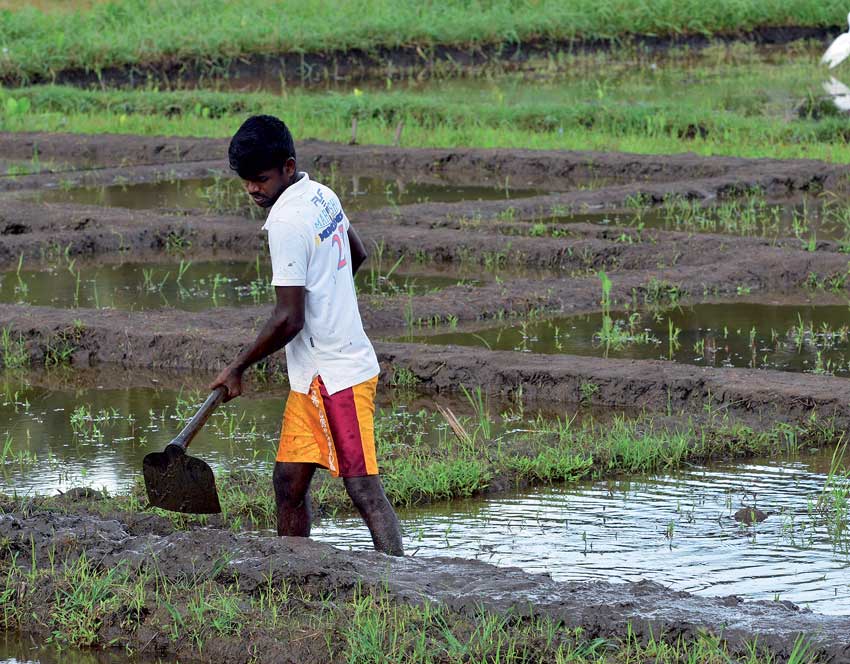Friday Dec 05, 2025
Friday Dec 05, 2025
Tuesday, 1 June 2021 01:04 - - {{hitsCtrl.values.hits}}

It should now be clear that nothing much has happened so far to improve the wellbeing of some 18 million people who depend directly or indirectly on rural agriculture. Why? One of the reasons could be the fact that the wellbeing of the farmer and consumer, was not uppermost in the minds of politicians who sought only short-term political gain – Pic by Shehan Gunasekara
 In the previous article that appeared in this paper on 10 May under the caption, ‘Attraction of Foreign Investments’, the strategy of attraction of such investment was discussed. Two notes should be added to it. The Port City project is brilliant as a concept. It is like providing a liveable place to live in in an inhospitable environment, as in the case of the Arctic or the moon, the rest of the country being unsuitable for FDI due to several missing rungs in the economic development ladder. It is also a ‘trickle down’ process of development like all FDI.
In the previous article that appeared in this paper on 10 May under the caption, ‘Attraction of Foreign Investments’, the strategy of attraction of such investment was discussed. Two notes should be added to it. The Port City project is brilliant as a concept. It is like providing a liveable place to live in in an inhospitable environment, as in the case of the Arctic or the moon, the rest of the country being unsuitable for FDI due to several missing rungs in the economic development ladder. It is also a ‘trickle down’ process of development like all FDI.
There is an alternate development strategy that may not need much by way of FDI. The reference is to rural agricultural development, the objective of which should be increasing the earnings of some 81% of people out of the total (World Bank, 2019), living in the rural areas of the country.
So far, the objective of development of agriculture has been realising self-sufficiency in food production which can be described as being a selfish motive of feeding the urban masses as in the case of reaching self-sufficiency in rice; the farmers remained poor as before the project began although rice yields increased tremendously. Besides increasing the earnings of farmers as well as of food production, the other objective of what is discussed in this paper is the protection of the natural environment.
The process of achieving these objectives involves: a) studying the subject thoroughly to identify the pros and cons and the stakeholders b) deciding on the areas of land to be set apart for an adequate forest cover including an elephant corridor, the area to be used as arable or cultivable land, the areas to be set apart for infrastructure and for urban purposes c) introduction of land reform for consolidation of fragmented holdings to increase their returns/productivity (more outputs from the same inputs) and d) construction of infrastructure and urban facilities. It is suggested that implementation of the project should start after setting up a pilot project to check its feasibility.
Present position
About 42% of the population of about 22 million people in the country earn less than $ 5.5 a day per person (World Bank, 2019); these are Sri Lanka’s (SL’s) poor; the same number for Malaysia which gained its independence a couple of years after SL, was 3%. Roughly 8 out of 10 persons in rural areas might be poor in SL. Undernourishment and malnutrition are reported to be rampant among them.
The main reason for this serious situation could be low productivity in rural agriculture. In fact, agricultural value addition per employee in SL was $ 2,789 as against $ 18,008 in Malaysia and $ 91,547 in Israel, in 2018, (World Bank 2010, constant). In addition, the number employed in rural agriculture is too high in SL being 25.0% of total employment, (CBSL, 2018), due to low productivity, while it is 10% in Malaysia and just 1.0% in Israel, (World Bank, 2019).
Since other sources of employment in rural areas are rare, the youth tend to encroach illegally on forested areas for cultivation. At present this appears to have been made legal and encroachment of forested areas is reported to be taking place on a vast scale, when the better alternative would have been increasing the productivity of the limited availability of cultivable land as in Israel for instance.
The bulk of land (over 80%) especially in rural areas is owned by the Government which has leased out (later most of it converted to grants) in small lots under the Land Development Ordinance (1935); the tenure conditions are so restrictive that holders find it difficult to improve the productivity of the land while incurring much expenditure especially for bribing officials to get over the red-tape; in fact the rank of the quality of land administration in SL is one of the worst in the world being 135 out of 141 countries (Global Competitiveness Report, 2019). Since most of the lots are not owned, the farmers find it difficult to access bank loans and to invest in expansion of cultivation or on value addition to production to earn better prices.
Fragmentation of the land is so heavy that 45% of the lots were less than ¼ acre in extent (out of a total of 3.3 million land parcels, according to the Census of Agriculture, 2002. (It may be worse now). This is mostly subsistence farming and mixed cropping; this is one of the reasons for low productivity in rural agriculture; the use of machinery on small scattered irregular plots requires long journeys and therefore is costly. In addition, as small quantities are being produced, it is infeasible to undertake further processing and provide for export.
As fragmentation of holdings becomes worse with each generation and incomes decline, some of the youth especially the educated leave the land in droves due to poor returns/low wages and migrate to the already crowded urban areas, or go abroad legally or illegally to work under harsh conditions, leaving the children and the elderly behind creating a severe social problem. Thus, consolidation of the small lots by way of land reform is essential for increasing output and reducing unit costs (or for improving productivity/value added per person) to improve incomes.
Undeveloped value chain
The situation is further worsened by the fact that little attention is being paid to strengthening the value chain for agricultural produce that should consist of the supply of quality planting material, well-maintained irrigation works, secured warehouses (with or without freezing facilities for villages to enable farmers to store farm produce and prevent elephants breaking into houses where harvested food products are usually stored), paved rural roads, marketing and research institutions, etc.; the research programs and extension services being undertaken appear to be ineffective in controlling disease, pest attacks, for increasing yields and for indicating the remunerative crops/products.
Low and unstable rural incomes
Worse still, the price the small subsistence farmer gets from the market for his produce does not compensate him adequately and so most farmers are frequently in debt; consumers too are affected unfavourably as the transporters/traders in particular demand high prices to compensate especially for high wastage (30-40%) in transit; heavy imports have to take place to make up for shortages, leading to a worsening of the trade balance. Agricultural prices also fluctuate because of weather conditions and natural disasters; incomes of farmers therefore do not remain stable; the average monthly income of a household (of about 4 persons) among the poorest 20% of households was Rs. 14,843, (Department of Census and Statistics, 2016).
The overall result of all this is the severe abuse of the natural environment and reducing the primary forest cover of SL to 2.6 % of the total extent of land, (FAO, 2010), which is the ‘sponge’ that stores the rain water received by the island of SL.
Current solutions create additional problems
The usual solution resorted to by the authorities has been to set up at central and provincial government level numerous ‘top-down’, under-funded, poorly coordinated, inefficient and mostly corrupt public institutions to service the sector with underpaid and de-motivated officials; through these institutions samurdhi payments and guaranteed prices at enormous expense have been thrown in indiscriminately; other subsidies like low priced fertiliser, planting material and disaster relief often get diverted, are of low quality and are not delivered on time.
Enhancement of productivity
It should now be clear that nothing much has happened so far to improve the wellbeing of some 18 million people who depend directly or indirectly on rural agriculture. Why? One of the reasons could be the fact that the wellbeing of the farmer and consumer, was not uppermost in the minds of politicians who sought only short-term political gain.
In order to increase farmer earnings, it may be necessary first to study the land reform movements adopted in Japan, China, Taiwan and South Korea successfully. One of the methods of improving productivity adopted in these countries has been the grant of ownership of larger holdings mainly by consolidation of the small unprofitable/subsistence farms. The small farmers who did not receive any land were given jobs in manufacturing undertakings. The success of these land/agrarian reform programs in terms of speed of implementation and the higher incomes earned by the farmers was ensured by state led planning and implementation.
The significant rise in the net incomes of the rural population, (as earnings increase with production increases, while unit costs decrease as costs are spread over a large area of output) enabled even the farmers in Japan, China, South Korea and Taiwan to invest in industries and services and undertake the education of their children to produce the technical and soft skills for such activities because of the rise in their incomes.
Problems and solutions of ownership
Next, SL has to study the social and economic consequences if ownership of the land is given to farmers. One of the problems that would be created would be the inclination on the part of some farmers to sell their land; if the land is sold to owners of larger holdings, it would not create much of a problem as it would lead to the improvement of productivity. If these farmers sell their land to outsiders, however, it might even lead to the breakup of the existing rural social fabric.
The best solution (as productivity and value addition are ensured) is the prohibition of selling the land and setting up of joint-stock companies of small farmers (or corporatisation). In such a case the farmer is in control of the management of production, further processing as well as marketing and could recruit the skilled people required like any other commercial enterprise or handover the management to specialised companies.
Urban/industrial clusters and infrastructure facilities
In addition, each large-scale cropping area (selected on the basis of best returns) could accommodate a well-located urban cluster/industrial area consisting of manufacturing and service-oriented enterprises to absorb the excess employment and the landless in the area as done in Israel.
The planning, policies, location and the provision of infrastructure facilities such as roads, water and electricity in the clusters and in the area around them is the responsibility of the state or the provincial authorities; the private sector could be incentivised to undertake the rest of the work such as setting up of the factories and the services required; businesses might readily do so when the primary inputs would be made available by the farmers on a large scale.
Conclusion
It has been a long disastrous journey with subsistence farming and heavy subsidies as well as protection where rural agricultural policies and operations in SL are concerned; it has failed to reduce rural poverty. The way out appears to be to find solutions particularly for improvement of the productivity of land and developing manufacturing, especially further processing of primary agricultural produce, mainly for export, to create better paid employment opportunities for those leaving farming and not to resort to simplistic solutions like increasing the extent of cultivated land which would lead to the destruction of the natural environment as well.
Therefore, a new land policy to replace it is timely. The consolidated versions of rural farming with urban clusters proposed here may not need much Government support like the Guaranteed Price Schemes from the state. It may also be noted that such farms could definitely contribute to higher increases in rural productivity. They could in addition generate additional investment due to higher earnings and discourage people especially women from going abroad for menial employment.
Such operations would also enable an increase in food production at lower prices that could reduce hunger, malnutrition, anaemia and sickness among rural people, while protecting the precious natural environment; more earnings could be made from exporting the surpluses. Higher rural incomes would increase the demand for various industrial goods and services from the rest of the country and speed up economic growth in the entire economy. This then is a dynamic model of development that could complement the slower, less dynamic ‘trickle down’ process often resorted to currently.
(The writer is a Development Economist.)